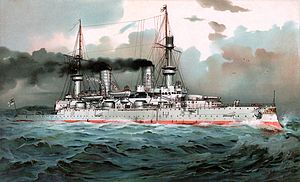
Back SMS Kaiser Wilhelm II. Czech Kaiser Wilhelm II. (Schiff, 1900) German SMS Kaiser Wilhelm II Spanish SMS Kaiser Wilhelm II French SMS Kaiser Wilhelm II Hungarian SMS Kaiser Wilhelm II Polish SMS Kaiser Wilhelm II Portuguese SMS Kaiser Wilhelm II Vietnamese 德皇威廉二世号战列舰 Chinese
 Lithograph of Kaiser Wilhelm II in 1900
| |
| History | |
|---|---|
| Name | Kaiser Wilhelm II |
| Namesake | Wilhelm II |
| Builder | Kaiserliche Werft Wilhelmshaven |
| Laid down | 26 October 1896 |
| Launched | 14 September 1897 |
| Commissioned | 13 February 1900 |
| Stricken | 17 March 1921 |
| Fate | Scrapped in 1922 |
| General characteristics | |
| Class and type | Kaiser Friedrich III-class pre-dreadnought battleship |
| Displacement | |
| Length | 125.3 m (411 ft 1 in) |
| Beam | 20.4 m (66 ft 11 in) |
| Draft | 7.89 m (25 ft 11 in) |
| Installed power |
|
| Propulsion |
|
| Speed | 17.5 knots (32.4 km/h; 20.1 mph) |
| Range | 3,420 nmi (6,330 km; 3,940 mi) at 10 knots (19 km/h; 12 mph) |
| Complement |
|
| Armament |
|
| Armor |
|
SMS Kaiser Wilhelm II ("His Majesty's Ship Emperor William II")[a] was the second ship of the Kaiser Friedrich III class of pre-dreadnought battleships. She was built at the Imperial Dockyard in Wilhelmshaven and launched on 14 September 1897. The ship was commissioned into the fleet as its flagship on 13 February 1900. Kaiser Wilhelm II was armed with a main battery of four 24-centimeter (9.45 in) guns in two twin turrets. She was powered by triple expansion engines that delivered a top speed of 17.5 knots (32.4 km/h; 20.1 mph).
Kaiser Wilhelm II served as the flagship of the Active Battle Fleet until 1906, participating in numerous fleet training exercises and visits to foreign ports. She was replaced as flagship by the new battleship SMS Deutschland. After the new dreadnought battleships began entering service in 1908, Kaiser Wilhelm II was decommissioned and put into reserve. She was reactivated in 1910 for training ship duties in the Baltic, but was again taken out of service in 1912.
With the outbreak of World War I in August 1914, Kaiser Wilhelm II and her sisters were brought back into active duty as coastal defense ships in V Battle Squadron. Her age, coupled with shortages of ship crews, led to her withdrawal from this role in February 1915, after which she served as a command ship for the High Seas Fleet, based in Wilhelmshaven. Following the end of the war in November 1918, Kaiser Wilhelm II was stricken from the navy list and sold for scrap in the early 1920s. Her bow ornament is preserved at the Military History Museum of the Bundeswehr in Dresden.
Cite error: There are <ref group=lower-alpha> tags or {{efn}} templates on this page, but the references will not show without a {{reflist|group=lower-alpha}} template or {{notelist}} template (see the help page).